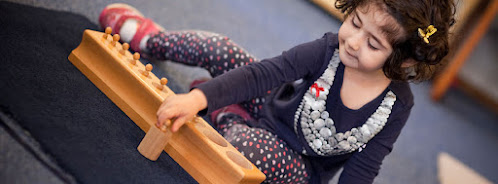Montessori excels at early childhood development, but it has advantages for children of all ages. If you have been considering enrolling your children in Montessori, the best advice is to do a little research so you understand the process, and then get the enrollment underway as soon as possible. Because Montessori is divided into sensitive periods that correspond to natural learning phases, the focus of each group can be discussed in simple terms.
Montessori Daycare
Beginning with infant care, Montessori focuses on appropriate childhood development in 3-year phases. This phase is called the “Absorbent Mind,” referring to the children being exposed to a wealth of new sensations and information as they become more aware of the world around them. Daycare students are engaged in developing fine motor skills, learning to communicate, and discovering social skills that help them interact with peers, adults, and the community at large.
Montessori Preschool
The second phase of Montessori put more focus on academic development and gross motor skills. Children will be more involved with activities that involve culture, language, music, and other fields. Many authentic Montessori workstations can be used for lessons in multiple academic fields, and children are encouraged to explore a range of play-based lessons.
Montessori Elementary
In Montessori elementary children enter what Maria Montessori called the “Reasoning Mind” phase. Creativity and critical thinking are nurtured, encouraging children to explore causation and effect, community involvement, and academic subjects such as math, science, and history. Montessori materials allow conquering multiple subjects by using workstations for different or concurrent purposes, with longer class periods to accommodate their studies.
No Time Like the Present
From infants through primary education, children benefit from Montessori education. The best results come from early enrollment and incorporating the Montessori Method in home life. Starting early allows children to use the advantages of hands-on learning throughout the process without having to adjust to a different type of instruction as they get older, potentially missing opportunities to maximize the Absorbent and Reasoning phases of development.
Keep in mind that only authentic Montessori schools are going to provide the full learning system developed by Maria Montessori. Ask about accreditation and check out parent testimonials. It won’t take long to determine that Montessori is perfect at every stage of childhood education.

